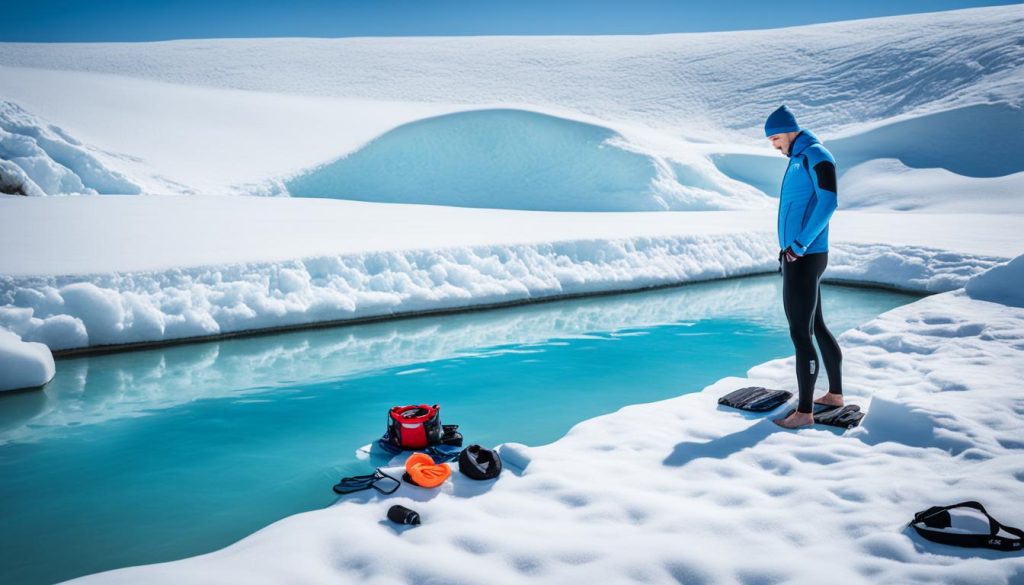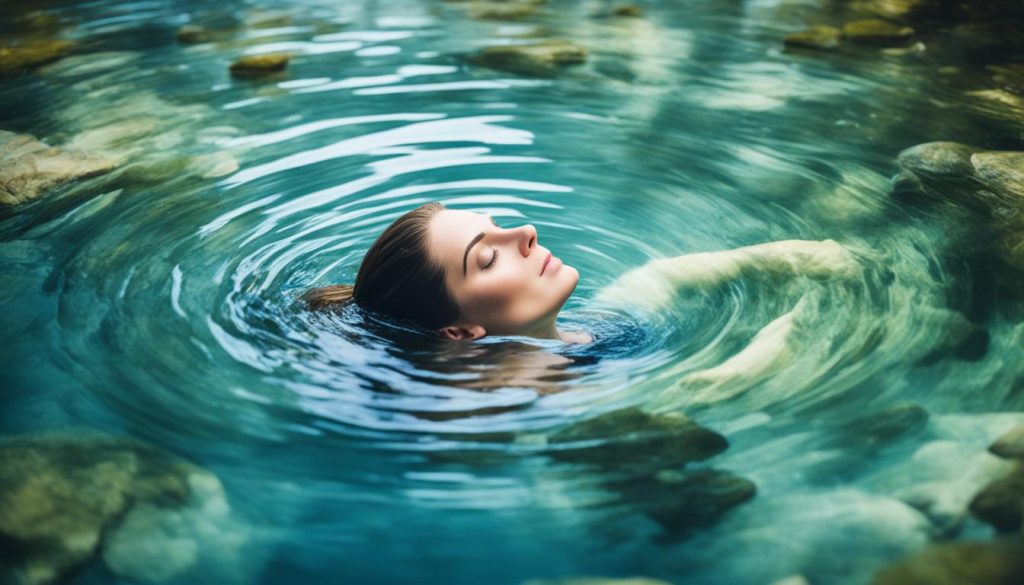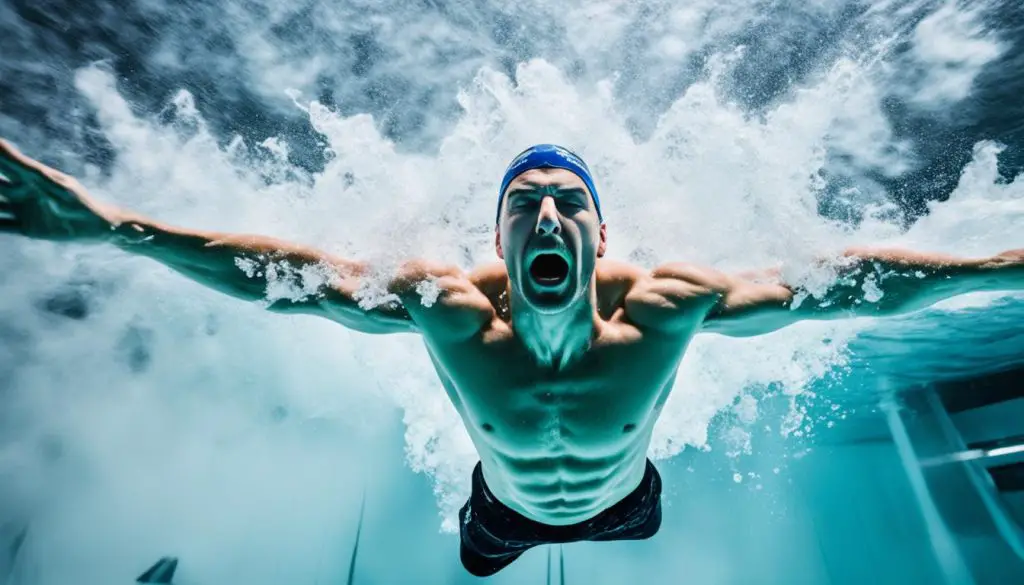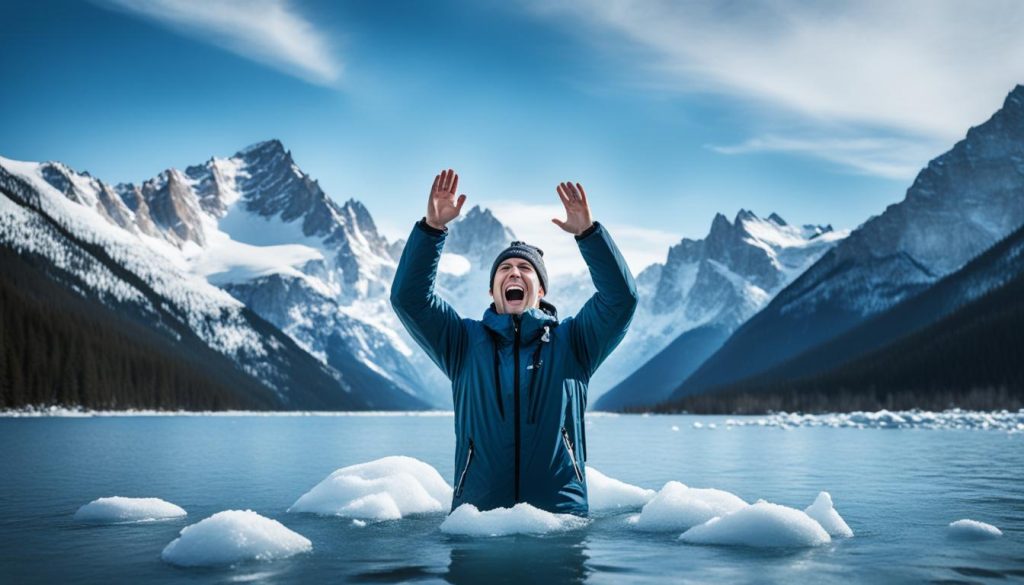Many find the Safe Cold Water Dip intriguing yet scary. It looks like a freezing challenge for only the brave. But, did you know with the right Cold Plunging Techniques, it can be easy and safe? This cool practice can become a good way to take care of your mind and body at home. By using smart Cold Plunge Safety Tips, it turns into a safe daily habit. Let's explore how to safely enjoy cold plunging.
Key Takeaways
- Begin with cooler water and gradually reduce temperature to acclimate safely to the cold.
- Follow a structured routine to build tolerance and reap full cold plunging benefits.
- Employ proper breathing techniques to relax the nervous system during immersion.
- Ensure the water quality is up to standard for a healthy and clean cold plunge experience.
- Discover a gradual acclimation routine that fits your personal health and safety levels.
- Comprehend the importance of correct duration and full submersion for effective therapy.
Embracing the Chill: Understanding the Benefits of Cold Plunging
Cold plunging is getting more popular around the world. People see it as more than a way for athletes to recover. It's a full-on wellness method. It boosts both your mind and body health.
The Mental Health Connection
Cold plunging is great for your mental health. Getting into cold water makes your body release happy hormones. It's super for fighting stress. It makes you tougher and helps control your heart rate.
Combating Inflammation with Cold Water Immersion
Cold water is a strong fighter against inflammation. It can lower swelling and speed up recovery. Regular dips can help with chronic pain too.
Why Athletes Count on Cold Plunge Therapy
Athletes really believe in cold plunge therapy. It's not just for sore muscles. It also makes them perform better. The therapy helps remove toxins and brings fresh blood to muscles. It gets them ready for what's next.
| Aspect of Cold Plunging | Mental Health Benefits | Inflammation and Recovery | Performance Enhancement |
|---|---|---|---|
| Stimulation of Vagus Nerve | Decrease in stress levels, Mood enhancement | Reduced inflammation response | Improved focus and calm |
| Endorphins Release | Elevated sense of well-being | Analgesic effect | Better pain management |
| Circulatory System Response | Enhanced resilience to stress | Accelerated muscle recovery | Increased endurance and stamina |
The Benefits of Cold Plunging are clear for health. They help with mental strength, less swelling, and better sports performance. With support from science, this practice is a great health choice. It helps people feel refreshed and balanced.
Easing Into the Cold: The Art of Temperature Transition
Starting with cold plunging needs a careful step-by-step approach. It's important to learn how to cold plunge safely. This means letting your body get used to the cold bit by bit. Just like runners don't just start sprinting, you shouldn't jump into cold water right away.
Start with cold showers before trying full cold plunges. This helps your mind and body get used to the cold. Gradually, you'll get better at handling the cold. Soon, you'll be ready for full cold plunges.

Starting with short cold showers helps ease into it. This makes the cold feel normal after a while. And it prepares you for longer, colder experiences.
| Week | Shower Duration | Temperature Adjustment | Notes |
|---|---|---|---|
| 1 | 60 seconds | Slightly cool | Focus on steady breathing |
| 2-3 | 2 minutes | Reduce by degrees | Acclimate steadily |
| 4 | 3 minutes | Noticeably cooler | Begin psychological adjustment |
| 5 | 4 minutes | Borderline cold | Monitor physiological response |
| 6 | 5 minutes | Cold | Prepare for full plunge |
The table above shows how to slowly get ready for cold plunging.
Taking it slow with the cold not only makes our bodies stronger but also builds our confidence. This is very important for anyone learning how to cold plunge safely.
Following this plan makes cold plunging a refreshing habit.
Cold Plunging Techniques: Tips for a Safe and Effective Cold Water Dip
To start cold water therapy right, know the safe practices. These steps make your experience safe and fun. They help your body and mind get stronger over time.
Gradual Temperature Reduction
Start with water that's a bit cold, like 50-60 degrees Fahrenheit. This makes it easier for your body to adjust. It’s a careful way to get used to the cold.
Then, make the water colder little by little. This helps your blood move better. It makes you warmer during the dip.
Creating a Consistent Plunge Routine
Having a routine is key for cold water dips. It helps your body get ready each time. This makes the cold easier to handle.
Try to stay in the water for at least two minutes. If your hands or feet get too cold, it’s okay to pull them out. This way, you still get the benefits.
Dunking your head first can help too. It slows down your heart and sends blood to important parts. This trick makes the cold plunge even better.
Use these tips to make every cold dip safe and useful. You’re not just getting used to the cold. You’re making your body strong and tough.
Building Cold Resilience: Pre-Plunge Preparation
The adventure of Effective Cold Water Therapy starts before touching the cold water. Pre-Plunge Preparation means getting ready in mind and body. It lets you face the cold better and get more good from it. Learning to control your breathing is a key step to get ready for the cold. Here's how to prepare:
- Start with deep breaths through your nose. This warms the air going into your lungs. It gets your body ready for the cold change.
- Breathe out slowly when you step into cold water. Doing this helps you stay calm. It stops you from gasping and breathing too fast.
- Try to take 5 to 8 full breaths a minute. This slow breathing calms you down. It helps your body relax even when it's cold.
Getting ready is more than just breathing right. Thinking about the plunge can help too. Imagine the cold as a helpful thing, making you stronger. By doing this, you make Pre-Plunge Preparation about more than just coping. It helps you get the most from Effective Cold Water Therapy.

Make these steps a key part of getting ready. They help make each cold plunge not just bearable, but also refreshing. By being well-prepared, you slowly get better at handling the cold. This makes your body respond better to the healing cold over time.
Maintaining a Pristine Plunge: Importance of Water Quality
The Importance of Water Quality in cold plunge therapy is huge. It affects the health benefits and how well the therapy works. As Effective Cold Water Therapy gets more popular, know this. The water's purity is key. If ignored, you might lose the health benefits you wanted.

Keeping water clean is a must, not just a suggestion. Most advanced cold plunge systems have special filters. They don't use chemicals to keep the water clean. Also, covering the tanks when not used helps a lot. It keeps dirt out, making the water remain clean and clear.
| Water Quality Aspect | Benefits | Maintenance Tips |
|---|---|---|
| Cleanliness | Prevents bacterial growth and skin irritation | Use a skimmer daily and backwash your filtration system regularly |
| Chemical-Free | Non-toxic, health-safe experience; better for the environment | Opt for UV or ozone purification methods |
| Clearness | Visually inviting and psychologically soothing | Keep the water covered when not in use |
| Sanitized | Minimizes the risk of disease; prolongs equipment lifespan | Regularly monitor water quality parameters such as pH and oxidation-reduction potential (ORP) |
To keep your setup working long and safe, you need these upkeep steps. It shows how vital Importance of Water Quality is. Good care makes every plunge into cold water both safe and exciting.
Full Immersion Experience: Maximizing Cold Plunge Benefits
Doing a full immersion cold plunge is great for both body and mind. It's not just about facing the cold. It's about feeling better and healthier too.
When you fully dive into cold water, it's more than just getting wet. You need focus and patience. These help improve your health and energy.
Key Areas to Focus on During Immersion
During a full immersion cold plunge, don't forget your neck and shoulders. The neck is important because of its sensory spots and its close location to the thyroid. This gland helps your body handle the cold.
Regulating Body Temperature with Thyroid Exposure
Keeping a good body temperature during a cold plunge is key. When you dip up to your neck, it helps your thyroid work better. This helps your body adjust to the cold.
Try to get the cold water up to just below your chin. This way, your thyroid helps keep your body's warmth. Soon, your body gets better at staying warm in the cold water.

The full immersion cold plunge is more than just a quick dip. It builds your strength over time. As you do it more, you'll feel more lively in and out of the water.
Listening to Your Body: Safe Duration in Cold Water
Jumping into cold water can feel amazing. How to Cold Plunge Safely means paying attention to how long you stay in. Everyone's body reacts differently to the cold. This knowledge is key for a safe and fun cold plunge.
Understanding Your Personal Cold Tolerance
Finding How to Cold Plunge Safely is unique for everyone. Know how your body feels in cold water. Start with just 30 seconds. Then, slowly increase the time. This way, you build up tolerance safely and keep making progress.
Recognizing Signs to End a Cold Plunge Session
Knowing when to stop is crucial in Cold Plunge Safety Tips. Pay attention to tingles, shivering, or stiff muscles. These signs mean it's time to warm up. Acting fast helps avoid problems like hypothermia. It shows why knowing your body's cold limits is important.
Mastering Breathwork for Optimal Cold Plunging
Your breath is your anchor when you get ready for a cold plunge. Mastering breathwork techniques helps you stay calm in cold water. It also empowers you to face the cold confidently. Let's look at ways to activate the parasympathetic nervous system. This makes your cold plunging experience more focused and calm.
Techniques to Stay Calm and Collected
Going into cold water can shock your body. So controlling your breath is key. These methods help keep calm:
- Start with diaphragmatic breathing to relax.
- Use nostril breathing to regulate and warm your breath.
- Follow a rhythm: breathe in for four counts, hold for four, breathe out for six, and pause for two.
Using these ways, you will feel calmer during your plunge.
Activating the Parasympathetic Nervous System
To activate your body's calm system, focus on your breathing. Follow these steps to get started:
- Breathe out slowly to relax your body.
- Try the humming bee breath to calm and focus.
- Use the 4-7-8 method: inhale for 4 seconds, hold for 7, exhale for 8.
These practices will make your cold plunge more soothing.
| Technique | Benefits | Guidelines |
|---|---|---|
| Diaphragmatic Breathing | Stress Reduction,Stabilizes Blood Pressure | Breathe deeply into your belly, expand on inhaling and contract on exhaling. |
| Nostril Breathing | Oxygen Efficiency, Warmer Air Intake | Breathe in slowly through one nostril, switch, then exhale through the other. |
| Humming Bee Breath | Vagus Nerve Stimulation, Mental Clarity | Take a deep breath in and hum as you exhale, feeling your throat vibrate. |
| 4-7-8 Technique | Anxiety Relief, Improved Sleep | Helps deeply relax by activating the calm response in your body. |
Improving your cold plunge with breathwork makes it better for both your body and mind. It turns the experience into something exciting and refreshing.

Adapting Cold Plunge Practices for Home Use
It's now super easy to start effective cold water therapy at home. Special cold plunge tanks for homes are available. They let you enjoy the cool and healthful effects any time. Choose the right equipment to make your daily routine better for your health.
RENU Therapy in the USA makes top-notch home cold plunge tanks. These tanks let you enjoy effective cold water therapy anytime. They're easy to use, making this healthy habit a part of your day. You can start or end your day with a cold plunge, right at home.
Getting a cold plunge tank for home isn't just about buying the tank. It's also about setting up a special space for your plunges. When setting up your home for cold water therapy, think about these things:
- Durability of materials to withstand repeated use
- Efficient temperature control for consistent cold plunges
- Ergonomic designs catered to comfort and safety
- Easy maintenance to keep the water clean and hygienic
Buying a home cold plunge setup is good for your health. You don't need expensive spa visits for cold water immersion. It shows you care about staying healthy, strong, and living a balanced life.

In short, making cold plunging part of your home is about good function and quality. It mixes old wellness traditions with new technology. With the right tank, staying healthy and full of energy is easy.
Cold Plunge Safety Tips: Protecting Your Health & Well-being
Safety is key in the exciting world of cold immersion therapy. It's vital to be cautious, as the cold shock is big. Following Cold Plunge Safety Tips makes the experience good and keeps you safe. Let's learn important rules before starting.
Consulting with Medical Professionals
Talking to healthcare experts is the first step. Consulting with Medical Professionals is a must, especially if you have health issues or take medicine. This advice makes your cold plunge plan safe and right for you.
Hydration and Substance Avoidance
Staying hydrated is key for cold plunge safety. Drink lots of water before diving in. This helps your body manage its temperature. Also, Hydration and Substance Avoidance means not having alcohol or caffeine before plunging. This prevents bad reactions to the cold.
Now, let's review safety with a table of do's and don'ts:
| Do's | Don'ts |
|---|---|
| Consult with healthcare professionals | Ignore medical advice |
| Stay hydrated with water | Consume alcohol or caffeine |
| Gradually acclimate to the cold | Rush the acclimation process |
| Understand your personal limits | Exceed beyond comfort zone |
| Enter the cold plunge calmly | Jump into the water suddenly |
By following these Cold Plunge Safety Tips, you create a safe cold water therapy habit. It's good for your health and has no big risks. Always put your safety first and don't compromise.
Conclusion
Cold plunging has many benefits for both body and mind. It improves blood flow, reduces swelling, and boosts the immune system. It's becoming popular for those wanting a healthy boost. But, it's crucial to start slow and listen to your body.
Jumping into cold water is more than just a thrill. It must be approached with care to be truly good for you. Doing it regularly and safely is key to its benefits. Remember, it doesn't fix everything. Staying safe and keeping things clean is also important.
In the end, cold plunging can greatly improve health when done right. Knowing how to do it safely means we can try it with confidence. It can be a great part of keeping healthy and feeling great.


